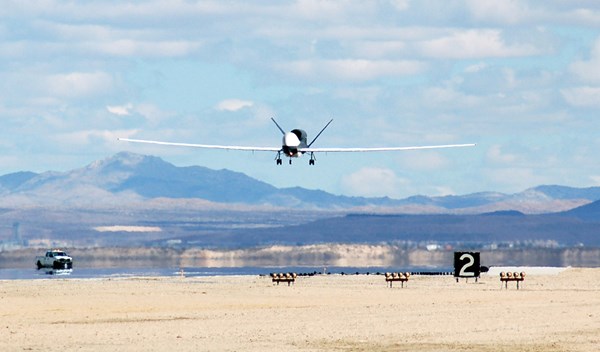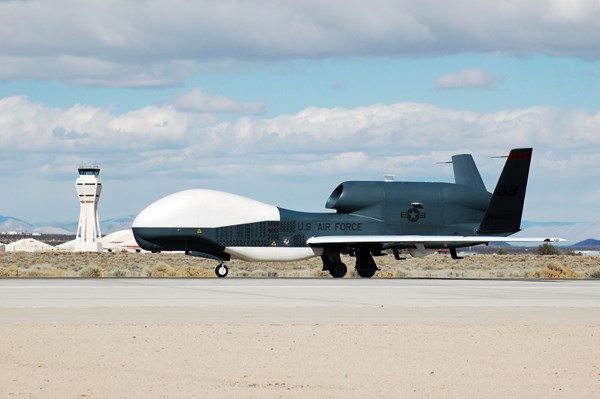EDWARDS AIR FORCE BASE, Calif., Feb. 21, 2006 (PRIMEZONE) -- A Global Hawk unmanned aerial vehicle, the workhorse of the U.S. Air Force's reconnaissance fleet in the fight against terrorism, returned here today after 167 missions and more than 4,800 flight hours in Southwest Asia. The RQ-4 Global Hawk high-altitude reconnaissance system is designed and produced by Northrop Grumman Corporation (NYSE:NOC).
Photos accompanying this news release are available at: http://media.primezone.com/noc/
Global Hawk unmanned air vehicle 3 (UAV-3), built as a demonstrator to test and evaluate technologies, was never intended for combat. However, Global Hawks were deployed shortly after the Sept. 11, 2001 terrorist attacks because the Air Force quickly realized the system's value in pinpointing critical targets.
UAV-3 has returned to its Edwards Air Force Base test facility because two production RQ 4A Global Hawk vehicles were deployed in January to the operational theater, where they are flying nearly continuous missions over Iraq and Afghanistan.
"The decision to deploy Global Hawk while still in development and the system's remarkable performance illustrate the Air Force's leadership role in the war on terror," said Gary Ervin, sector vice president, western region, for Northrop Grumman Integrated Systems. "In supporting the deployment, Northrop Grumman values its role as a member of the Air Force's operational team."
The Global Hawk system features an unmanned air vehicle that flies at altitudes over 60,000 feet above inclement weather and prevailing winds. Global Hawk can survey vast geographic regions with pin-point accuracy. Mission parameters are programmed into Global Hawk. Under the safeguard and control of ground-based operators, it can take off, fly, return and land autonomously.
"UAV-3 provided unprecedented intelligence information to combatant commanders almost continuously since its arrival in theater," said Randy Brown, director of the Air Force Global Hawk Systems Group at Wright-Patterson Air Force Base, Ohio. "The men and women who designed, developed and are now operating Global Hawk -- in the Air Force and on the industry team -- take enormous pride in the performance of this system."
Lt. Col. Mark Corley, a ground-based Global Hawk pilot for the Air Force's 9th Reconnaissance Wing, added, "The program has learned a great deal from this one deployed test asset, which will bring even greater Global Hawk capabilities to the warfighter of the future."
Over its operational deployment, UAV-3 logged the most combat hours of any single high-altitude UAV, providing hundreds of thousands of images to military decision-makers.
The original plans for UAV-3 called for about 40 test flights a year over just a few years. Not only has it flown more than four times that many flights in just 18 months, it achieved a 95 percent mission effectiveness rate and at one point flew 40 missions in a row with no reported system problems.
To date, deployed Global Hawks have flown more than 5,400 combat hours in more than 260 missions. Overall, the entire fleet of Global Hawk vehicles has logged more than 8,700 flight hours.
The Global Hawk industry team, led by Northrop Grumman's Integrated Systems sector in San Diego, Calif., comprises U.S. and international companies. Global Hawk's primary elements are provided by the following team members:
-- Integrated sensor suite: Raytheon Space and Airborne Systems,
El Segundo, Calif.
-- Ground station: Raytheon Intelligence and Information Systems,
Falls Church, Va.
-- Engine: Rolls-Royce Corporation, Indianapolis, Ind.
-- Communication system: L-3 Communications West, Salt Lake
City, Utah.
-- Wing assembly: Vought Aircraft Industries, Dallas, Tex.
-- Tail assembly and other composite structures: Aurora Flight
Sciences of West Virginia, Bridgeport, W.Va.
Northrop Grumman Integrated Systems is a premier aerospace and defense systems integration organization. Headquartered in El Segundo, Calif., it designs, develops, produces and supports network-enabled integrated systems and subsystems optimized for use on networks. For its government and civil customers worldwide, Integrated Systems delivers best-value solutions, products and services that support military and homeland defense missions in the areas of intelligence, surveillance and reconnaissance; space access; battle management command and control; and integrated strike warfare.

